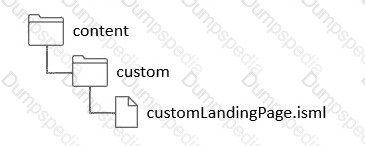A developer wants to use an external application to manage their stores information (such as opening
hours, and so on), and see their changes in their B2C Commerce Staging instance aas son as they are saved. What is the appropriate technique the developer should perform to allow the merchant to create a new store in this scenario?
A.
A POST request to the Stores Data OCAPI.B. A PUT request to the Stores Data OCAPI.
B.
A PATCH request to the Stores Data OCAPI.
C.
An UPDATE request to the Stores Data OCAPI.
D.
Siempre que sea un objeto standard será put en vez de post
A PATCH request to the Stores Data OCAPI.
A Digital Developer has detected storefront pages being rendered with an error message. After inspecting the log files, the Developer discovered that an enforced quota is being exceeded.
What action should the Developer take to stop the quota violation?
A.
Rewrite the code that is causing the overage.
B.
Change the Business Manager configuration for the quota settings.
C.
Take no action, the overage will be resolved when concurrent visitors are reduced.
D.
Ask support to remove the quota limit.
Change the Business Manager configuration for the quota settings.
Given the file structure below, which ISML method call renders the customLandingPage template?

A.
ISML.renderTamplate(‘cartridge/templates/default/content/custom/customLandingPage’);
B.
ISML(‘content/custom/customLandingPage’);
C.
ISML.render(‘content/custom/customLandingPage’);
D.
ISML.renderTemplate(‘content/custom/customLandingPage’);
ISML.renderTemplate(‘content/custom/customLandingPage’);
A Digital Developer has a site export file on their computer that needs to be imported into their sandbox. How should the developer update their sandbox with the data in this file?
A.
Connect and import the file using the remote option within the Site Import & Export Business Manager module.
B.
Upload and import the file using the local option within the Site Import & Export Business Manager
module.
C.
Upload the file to the Impex WebDAV directory and import using the Site Import tool within UX
Studio.
D.
Upload the file to the Static WebDAV directory and import using the Import & Export Business
Manager module.
Upload and import the file using the local option within the Site Import & Export Business Manager
module.
A Digital Developer must give users the ability to choose an occasion (holiday, birthday, anniversary, etc.) for which gifts are currently being selected. The data needs to be persistent throughout the current shopping experience. Which data store variable is appropriate, assuming there is no need to store the selection in any system or custom objects?
A.
Request scope variable
B.
Page scope variable
C.
Session scope variable
D.
Content slot variable
Session scope variable
Server.get(‘Show’, consentTracking.consent, cache.applyDefaultCache, function (req,res,next){
Var Site = require(‘dw/system/Syte”);
Var pageMetaHelpter = require(‘*/cartridge/scripts/helpers/pageMetaHelper’);
pageMetaHelpter.setPageMetaTags(req.pageMetaData, Site.current);
res.render(‘/home/homePage’);
Missing code here
}, pageMetadata.computedPageMetadata);The controller endpoint code snippet above does not work.
Which line of code should the developer use to replace line 6 and correct the problem?
A.
next();
B.
return res;C. res.next();
C.
req.next();
next();
A developer working on a simple web service integration is asked to add appropriate logging to allow future troubleshooting. According to logging best practices, which code should the developer write to log when an operation succeeds, but has an unexpected outcome that may produce side effects?
A.
Logger.info(‘Unexpected service response’)
B.
Logger.debug(‘Unexpected service response’)
C.
Logger.error(‘Unexpected service response’)
D.
Logger.warn(‘Unexpected service response’)
Logger.warn(‘Unexpected service response’)
Which three techniques improve client-side performance in production while following documented best practices? (Choose three.)
A.
Use one style sheet for each ISML decorator template.
B.
Place CSS outside of templates.
C.
Compress CSS.
D.
Use inline Javascript.
E.
Combine several images into a single image.
Use one style sheet for each ISML decorator template.
Compress CSS.
Use inline Javascript.
A Newsletter controller contains the following route:
Server.post(‘Subscribe’, function (req,res,next){
var newsletterForm = server.forms.getForm(‘newsletter’);var CustomObjectMgr =
require(‘dw/object/CustomObjectMgr’);
if(newsletterForm.valid){
try{
var CustomObject =
CustomObjectMgr.createCustomObejct(‘NewsletterSubscription’, newsletterform.email.value);
CustomObject.custom.firstName = newsletterForm.fname.value;
CustomObject.custom.lastName = newsletterForm.lname.value;-
} catch(e){
//Catch error here
}
}
next();
});
Assuming the Custom Object metadata exists, why does this route fail to render the newsletter template
when the subscription form is correctly submitted?
A.
Custom Objects can only be created by Job scripts
B.
The Subscribe route is missing the server.middleware.httpt middleware.
C.
The CustomObjectMgr variable should be declare outside of the route
D.
The Custom Object creation is not wrapped in a Transaction
The Custom Object creation is not wrapped in a Transaction
A Digital Developer selects “Show Orderable Products Only” in the Search > Search Preferences Business Manager module. Which business goal does this accomplish?
A.
Exclude products from search results if Available to Sell (ATS) = 0.
B.
Exclude back-ordered products from showing on the website.
C.
Block displaying the product detail page if Available to Sell (ATS) = 0.
D.
Exclude pre-order products from search results.
Exclude products from search results if Available to Sell (ATS) = 0.
| Page 1 out of 21 Pages |
| Group | Pass Rate | Key Advantages |
|---|---|---|
|
Used Practice Tests
|
90-95% |
• Familiarity with exam format • Identified knowledge gaps • Time management practice |
|
No Practice Tests
|
50-60% |
• Relies solely on theoretical study • Unprepared for question styles • Higher anxiety |
